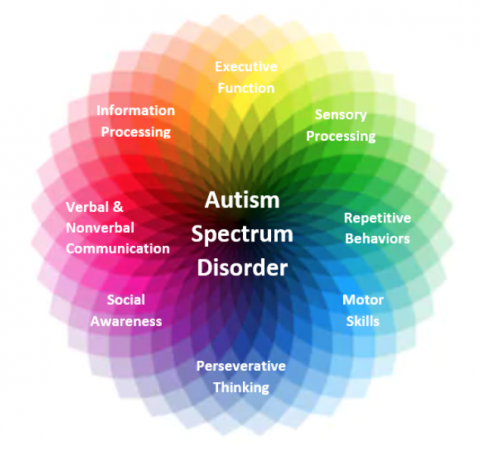The Function of Education in Supporting Trainees with Autism: Finest Practices
The Function of Education in Supporting Trainees with Autism: Finest Practices
Blog Article
Exploring Autism: Strategies for Effective Communication and Interaction
Efficient communication and interaction with individuals on the autism spectrum require a detailed understanding of their special demands and choices. Strategies such as using clear language, making use of aesthetic assistances, and cultivating constant regimens can substantially boost interaction and minimize stress and anxiety. Identifying the value of non-verbal hints and shared rate of interests paves the means for purposeful links. Nevertheless, the complexities of these methods reveal more factors to consider that merit exploration, specifically in exactly how they can be adapted to private experiences and varied contexts. What might these adjustments appear like in practice?
Comprehending Autism Range Disorder
Autism Range Problem (ASD) includes an array of neurodevelopmental conditions identified by challenges in social interaction, interaction, and repetitive habits. The term "range" reflects the diverse indications and varying degrees of extent experienced by individuals with ASD. While some may show significant problems, others might display high-functioning qualities, allowing for higher self-reliance in life.
The onset of ASD normally occurs in early childhood years, with signs typically identifiable by age 2. Early indicators may consist of postponed speech growth, limited eye get in touch with, and problems in recognizing social cues. Although the accurate etiology of ASD stays vague, study recommends a combination of environmental and genetic aspects plays a crucial role in its development.
As an outcome, interventions and support customized to individual demands are necessary for promoting communication and social abilities. Recognizing the intricacy of ASD is important for promoting understanding, acceptance, and reliable techniques that facilitate significant interactions with people on the spectrum.

Value of Clear Interaction
Efficient communication is vital for cultivating understanding and link, especially for individuals with Autism Range Condition (ASD) Clear communication not only promotes social communications however also boosts the person's ability to express their demands, emotions, and thoughts. For people with ASD, the nuances of language can often be testing; for that reason, using unambiguous and uncomplicated language is vital.
Moreover, clear interaction helps in reducing irritation and anxiety that might arise from misconceptions. When messages are conveyed in a straight and consistent way, people with ASD are better outfitted to interpret details accurately, which can dramatically improve their social engagement and involvement in numerous settings.
Developing routines and utilizing aesthetic supports can additionally bolster clear communication. These methods provide individuals with foreseeable frameworks that help understanding and retention of information. Furthermore, proactively listening and being patient during communications advertises an encouraging environment where people with ASD really feel valued and understood.
Ultimately, prioritizing clear interaction not just encourages individuals with ASD however also cultivates even more meaningful links with their peers, caregivers, and the bigger community, leading the way for collective partnerships and comprehensive communications. - autism
Non-Verbal Interaction Strategies
Interaction extends beyond words, and for individuals with Autism Spectrum Disorder (ASD), non-verbal cues play a considerable function in interactions. Non-verbal communication methods can include faces, gestures, body language, and eye contact, all of which function as vital components for conveying intentions and emotions.
Recognizing and analyzing these non-verbal signals can boost communications with people with ASD. A warm smile or open position can create an inviting ambience, official website motivating interaction. Likewise, using aesthetic help-- such as photo cards or symbols-- can link interaction spaces and help share messages better.
It is additionally crucial to be mindful of individual area, as individuals with ASD might have different comfort degrees relating to proximity. Observing their responses to physical nearness can inform ideal modifications.

Producing Supportive Settings
Producing a helpful environment is crucial for cultivating positive interactions and improving the well-being of people with Autism Spectrum Disorder (ASD) Such atmospheres can considerably reduce anxiousness and produce a feeling of security, allowing individuals to express themselves a lot more freely.
To attain this, it is vital to consider sensory level of sensitivities that individuals with ASD might experience. Modifying the physical area to include soft illumination, marginal background sound, and comfortable seating can produce a calming environment. Additionally, utilizing regular routines and clear aesthetic schedules can assist individuals prepare for shifts and lower uncertainty, additional promoting comfort.
Social areas should be structured to reduce frustrating stimuli while giving opportunities for interaction in recommended activities. Assisting in locations designated for peaceful time can additionally work as a refuge during minutes of stress and anxiety. Importantly, integrating components of selection empowers individuals, enabling them to work out firm in their setting.

Motivating Social Interactions
Promoting social communications among people with Autism Spectrum Problem (ASD) requires deliberate strategies that prioritize comfort and involvement. Establishing predictable regimens can help minimize anxiety, making social settings extra approachable. Producing organized environments with specified duties and roles enables people to involve without the overwhelming pressure of unstructured social characteristics.
Incorporating interests and strengths into social pop over here activities can act as a stimulant for interaction. For instance, organizing group activities around shared leisure activities or subjects of fascination can facilitate natural conversations and links. In addition, utilizing visual supports, such as pictorial routines or social scripts, can help in recognizing social signs and assumptions.
Designing ideal social actions is essential - autism. Adults and peers ought to demonstrate effective communication techniques, including active listening and turn-taking. Role-playing scenarios can also provide a safe space for people to exercise these abilities
Last but not least, promoting peer connections with inclusive methods is vital. Motivating inclusive playdates or group getaways can develop possibilities for socializing in a comfortable setting. By implementing these strategies, caretakers and teachers can dramatically improve social interactions for individuals with ASD, promoting their total social advancement and well-being.
Final Thought
In final thought, reliable interaction and interaction techniques are crucial for supporting individuals with Autism Spectrum Condition. Inevitably, these techniques equip individuals with autism to browse social landscapes, advertising their total well-being and allowing the advancement of enduring partnerships.
Reliable interaction and interaction with individuals on the autism spectrum necessitate an extensive understanding of their special requirements and choices. Clear interaction not only assists in social communications however likewise improves the individual's capacity to express their demands, feelings, and ideas.Cultivating social communications amongst individuals with Autism Spectrum Disorder (ASD) calls for willful methods that prioritize comfort and engagement. By implementing these educators, caretakers and methods can considerably enhance social communications for individuals with ASD, promoting their total social advancement and health.
In final thought, effective communication and interaction their website approaches are necessary for supporting people with Autism Spectrum Problem.
Report this page